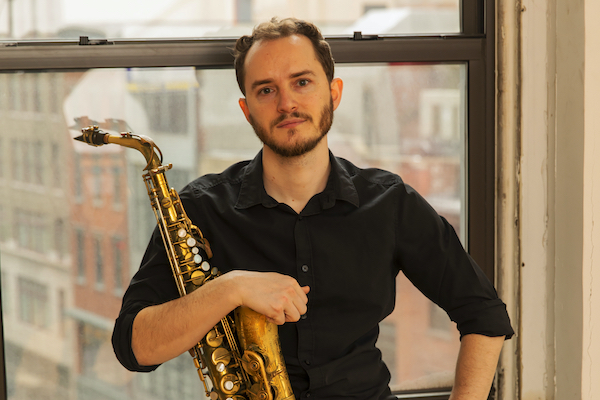Oct 28, 2025 10:47 AM
In Memoriam: Jack DeJohnette, 1942–2025
Jack DeJohnette, a bold and resourceful drummer and NEA Jazz Master who forged a unique vocabulary on the kit over his…

Remy Le Boeuf has received many commissions in recent years, fueling his work as a composer and arranger.
(Photo: Levi Mandel)Remy Le Boeuf turned to an oft-tapped source—the 19th-century tales of the Brothers Grimm—to gather grist for the musical narrative in the instrumental title suite for Assembly Of Shadows (SoundSpore), his new big band album. Like singer-songwriter Cécile McLorin Salvant’s unrecorded and more transgressive song cycle Ogresse, the suite is about a girl who ventures away from the safety of home and hearth into the unruly forest.
“I like the structure of stories and the challenge of telling them with music,” Le Boeuf said in early November at his Brooklyn apartment. He referenced an earlier string quartet based on the Grimms’ “Hansel and Gretel,” and another five-part suite based on Franz Kafka’s short story “A Dream,” which is the centerpiece of the 2016 Le Boeuf Brothers release, Imaginist (New Focus/Panoramic). On that project—which featured strings by the Jack Quartet—the leader played alto saxophone, oboe and bass clarinet, alongside his identical twin, Pascal Le Boeuf, on piano.
“I molded and shaped the story over the past couple of years,” Le Boeuf, 33, said of the current work. “I wanted it to be flexible, something that could maybe be turned into a ballet.”
When applying for the 2016 grant from the American Composers Forum through the Jerome Foundation that allowed him to embark on creating Assembly Of Shadows, Le Boeuf submitted a recording of the album-opening “Strata,” originally a 2015 commission from the Keio Light Music Society in Japan. The album’s second track is Le Boeuf’s arrangement of Ornette Coleman’s “Honeymooners” (prepared for a Jazz at Lincoln Center Orchestra concert as a feature for reedist Ted Nash), on which the saxophonist uncorks a darting, episodic soprano solo that interacts seamlessly with the backgrounds and themes of the composition.
As Le Boeuf molded and shaped, he fulfilled commissions from the BMI Foundation, SFJAZZ, the New York Youth Symphony and vocalist Sachal Vasandani. Then he assembled an 18-piece orchestra, calling musicians he has played with in one context or another since 2004, when he moved from Santa Cruz, California, his hometown, to attend Manhattan School of Music. Meanwhile, he addressed the “tremendous financial challenge” of recording a project of this scale, using his own savings, as well as a grant from the Copland Fund, a micro-grant from Young Arts and donations from a GoFundMe campaign.
Asked what qualities he seeks from personnel, Le Boeuf replied, “In general, I want people to be familiar with classical and jazz traditions, since both are so important in my music, which is especially challenging. Everyone’s part is an individual voice, so I demand interpretative flexibility—you have to be fully engaged and independent the whole time.”
“Remy’s writing is rich and delicate, and needs a lot of intricate dynamics, phrasing, sound color and articulations in order to dance, to come alive,” said Philip Dizack, who plays two unfettered trumpet solos on the album. “He created a landscape for me, knowing some of the ways I can play. When we were in college, he was writing simple, beautiful, personal melodies—it’s amazing to hear how [his work has] blossomed and culminated in this environment.”
Assembly Of Shadows is Le Boeuf’s second leader outing, following the spring 2019 release Light As A Word (Outside in Music), a program of originals interpreted by tenor saxophonist Walter Smith III, pianist Aaron Parks, guitarist Charles Altura, bassist Matt Brewer and drummer Peter Kronreif—all old friends. They sustain a conversational attitude in which Le Boeuf’s distinctive dark-hued instrumental voice emerges with clarity and focused intention.
The 2019 releases also bolster a discography that includes four recorded collaborations with his twin.
“Our albums together were very rewarding,” Le Boeuf said. “I love playing with Pascal because he creates a composition behind each solo. He’s not a traditional improviser, which makes it fun to improvise with him. But here I’m coming back more to my roots. Because I’m not balancing my voice with my brother’s, I can be more unabashedly who I am.” DB

Jack DeJohnette boasted a musical resume that was as long as it was fearsome.
Oct 28, 2025 10:47 AM
Jack DeJohnette, a bold and resourceful drummer and NEA Jazz Master who forged a unique vocabulary on the kit over his…

D’Angelo achieved commercial and critical success experimenting with a fusion of jazz, funk, soul, R&B and hip-hop.
Oct 14, 2025 1:47 PM
D’Angelo, a Grammy-winning R&B and neo-soul singer, guitarist and pianist who exerted a profound influence on 21st…

Kandace Springs channeled Shirley Horn’s deliberate phrasing and sublime self-accompaniment during her set at this year’s Pittsburgh International Jazz Festival.
Sep 30, 2025 12:28 PM
Janis Burley, the Pittsburgh International Jazz Festival’s founder and artistic director, did not, as might be…

Jim McNeely’s singular body of work had a profound and lasting influence on many of today’s top jazz composers in the U.S. and in Europe.
Oct 7, 2025 3:40 PM
Pianist Jim McNeely, one of the most distinguished large ensemble jazz composers of his generation, died Sept. 26 at…

Drummond was cherished by generations of mainstream jazz listeners and bandleaders for his authoritative tonal presence, a defining quality of his style most apparent when he played his instrument unamplified.
Nov 4, 2025 11:39 AM
Ray Drummond, a first-call bassist who appeared on hundreds of albums as a sideman for some of the top names in jazz…